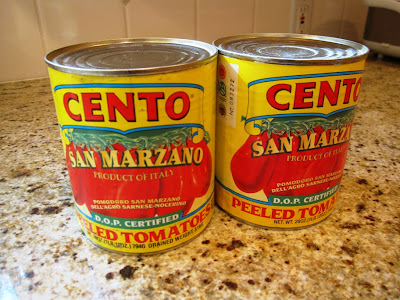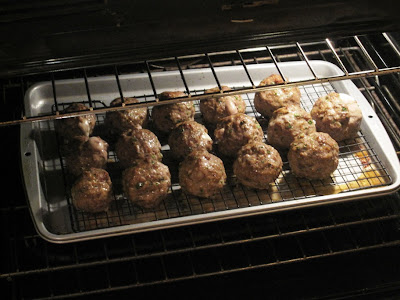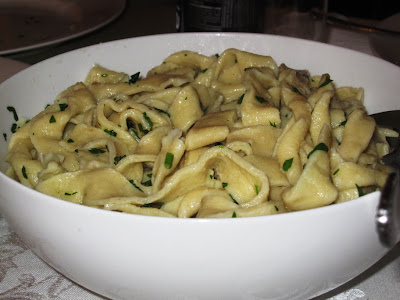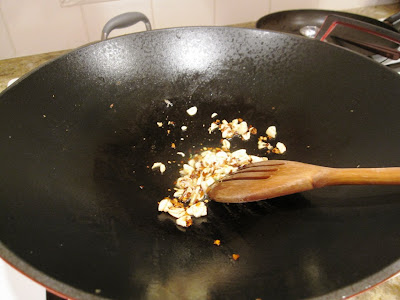Something about meat balls and pasta that's always so comforting. Abby (my friend's daughter) is a huge fan of it and for February I decided to satisfy her cravings as it's one of her most commonly ordered food items in a restaurant no matter where she goes.
This recipe is fairly involved as it calls for all 3 main ingredients - pasta, sauce, meat balls all to be home made. I have never made a sauce or pasta from scratch before, so I know I am in for some challenges. What's worse is that I don't have a pasta rolling machine or slicer, so I was most worried about the textures of the pasta but I decide to give it a go anyway.
First I started with the sauce, since it could have been made ahead of time. I have to tell you this is the most aromatic and flavor-rich sauce I have ever tasted. It took a lot of time, but really worth it. Also everything is done in an oven, so you do have the benefit of doing other things while the sauce is cooking. I started with finely chopped onions, leeks and fennels in the oven. Yes that was a lot of chopping, a food processor definitely would have helped but I was too lazy to get that out.
 |
| Onions, Leeks and Fennel in the Oven |
After the vegetables are baked for about 45 minutes, they become very caramelized and that's when I added brown sugar and red wine vinegar. Return the dish back to the over for another 20 minutes. At this point, you can totally smell the richness aroma already in the house. While this is cooking in the oven, I prepare the tomatoes. The book called for canned San Marzano tomatoes, and luckily I was able to find those in my local market. They were very expensive!! Think almost 10x the cost of regular canned peeled tomatoes. Reason being they are imported from a region by the same name in Italy, renowned for growing the best plum tomatoes for sauces.
 |
| Imported San Marzano Tomatoes |
After opening the cans, I picked out all the tomatoes and loosely chopped them as they were very soft. There were quite a bit of juice/sauce left, I saved them for later use. Look at the bright red colors!
 |
| Canned San Marzano Tomatoes |
 |
| Drained and Chopped |
The sauce also called the use of a flavoring sachet. That was pretty easy to put together, a cheese cloth tied with bay leaves, pepper corns, thyme sprigs and some crushed garlic.
 |
| Flavor Sachet Ingredients |
 |
| Flavor Sachet Tied with Butcher Twine |
After baking the tomatoes along with the vegetables and the flavoring sachet, my entire house smelled like Italy :) That's pretty much when my first group of friends arrived. You are supposed to bake the entire sauce for 1.5 hours, stirring every 30 minutes. The book warned the sauce is EXTREMELY thick and it is, as the flavor deepens with all the liquids evaporating.
 |
| After First 30 Minutes - Sauce Looked Rich Already |
As the sauce is baking, I make preparations of the pasta dough. I have to confess that I used a slightly different recipe here because I didn't have a pasta roller. I searched online and found
Homemade Pappardelle recipe from Mike Chiarello @ Food Network that didn't require a pasta machine. The ingredients were extremely simple: regular flour, Semolina flour, oil and egg. I made a well and poured the egg mixture in.
 |
| Pasta Dough Making - Egg Well |
After kneeling the finished dough for 10 minutes, I separated into two halves and let the dough refrigerate and rest.
 |
| Pappardelle Pasta Dough |
Next comes the meat ball preparation, too bad that's when I got really busy and forgot to snap pictures! But the recipe basically called for 3 lbs of ground meat, I know that's a lot! But it does make for decent sized meat balls (recipe called for 12, I ended up with 16 since I had a little extra meat). The ground meat are suppose to be different kinds (sirloin, chuck, pork butt and veal!), but if you cannot find all these, you can pretty much substitute with 2 lbs of ground beef and 1 lb of ground pork. After seasoning and adding in the bread crumb, I tested the meat mixture for seasoning, it did turn out to be not salty and flavorful enough, so I added a little bit of salt. This is where I think the recipe could use some help in terms of the flavoring, as the meat mixture tasted somewhat bland - but it could be my Asian/Chinese inner self speaking as we almost always mix in a lot of seasoning with ground meat, in this case, since the sauce is so rich, maybe it's intended for the meat balls themselves to be fairly true to its simple taste.
The other twist to the meat balls is it's stuffed with fresh Mozzarella cheese. I found this to be interesting as it added saltyness and flavor to the center of these large meat balls.
 |
| Meatballs stuffed with Mozzarella Cheese |
The meat balls are baked on a rack for about 18 minutes, it looked so very tasty! You can see the cheese oozing through the meat.
 |
| Meatballs stuffed with Mozzarella Baking |
Now we need to roll out the pasta dough for final cooking. This is where I really wish I had a pasta maker. My friend helped me muscle through the rolling and it still wasn't thin enough in the end, but we came pretty close.
 |
| Rolled Out Pasta Dough |
After many hours of work, I put it all together. Butter tossed pappardelle with fresh parsley, tomato sauce and meat balls all made from scratch is like match made in heaven. They look and tasted amazing, especially the sauce with the rusty pasta.
 |
| Meatballs with Home Made Tomato Sauce |
 |
| Home Made Pappardelle Pasta |
Tasting:
The taste is definitely worth the effort. Chewiness of the pasta worked well with the thick and rich tomato sauce. I am not sure if I would be buying $40 tomatoes to make this sauce every time I make a pasta dish, but once in a while it's definitely worth the splurge. The meat balls came out much more bland themselves than I imagined, but maybe because I had some high flying expectations. I think the recipe kept the meat simple on purpose to high light the richness of the sauce, but if I am going to make this again, I would definitely kick up the seasoning in the meat. Overall this was a very successful dinner and I really enjoyed the home made experience! I would definitely like to own a pasta maker though to make things a bit easier. :)


























